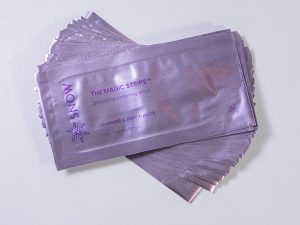Are whitening strips bad for teeth? The answer is multi-faceted, but whitening strips that contain bleaching ingredients like hydrogen peroxide can cause damage to your teeth, both to the enamel and as newer studies are finding, also to the dentin beneath the enamel.
In this article, we’ll also address the following points:
- How do white strips damage teeth?
- Why your teeth hurt when you use white strips
- White strips pros and cons
We hope this information helps you decide on the best and safest way for you to get a brighter smile.
What are whitening strips?
Whitening strips usually consist of a thin plastic film containing a whitening gel. This gel often contains hydrogen peroxide, in the US anywhere from 5% to 15%. They are available over the counter and are worn for around 30 minutes per day, although that time can vary depending on the brand you choose.


Treatment is usually quite short, typically up to 2 weeks at the most. They can be effective in removing extrinsic stains from your tooth’s enamel — extrinsic refers to the stains that are on the surface of your teeth. They can’t, however, remove intrinsic stains, or those that reside underneath your enamel, in your dentin, and beyond.
Additionally, they can cause sensitivity to your teeth and gums if used incorrectly.
On the other hand, many people are able to whiten their teeth with white strips without experiencing damage or sensitivity. We know this can be a bit confusing and contradictory, which is why in this article we’ll talk all about the pros and cons of whitening with white strips, and some of the science behind it.
How do whitening strips work?
Typically, white strips take the form of thin rectangular strips. One side has a whitening gel and some sort of adhesive ingredient, and the other side is smooth. The strips come attached to a plastic backing, much like stickers. There are usually different strips for the tops and bottoms of your teeth, the top strip generally being the longer one.
To use the strips, you peel each strip off of the backing and gently press it onto your teeth. White strips can be worn anywhere from 10 minutes to an hour, depending on the kind you get.
Once the wearing time has passed, you toss out the strips and rinse out your mouth. Oftentimes, strips will leave a gooey gel behind on your teeth, so do your best to get that off by rinsing.
Of course, the strips you buy will have instructions, and you should follow those carefully, as they may differ from other brands.
White strips ingredients
The ingredients in white strips can vary depending on the brand you buy, but many white strips contain ingredients like:
- Hydrogen peroxide: The active whitening ingredient that bleaches enamel
- Polyvinylpyrrolidone (PVP): Stops tooth enamel from developing future stains
- Sodium hydroxide: Stain remover
- Glycerin: Used to keep strips in place
- Hydroxypropylcellulose: Helps with strip adhesion
Are whitening strips bad for your teeth?
Whitening strips are not bad for your teeth, but they can be because of hydrogen peroxide and other bleaching ingredients. So let’s dive a little deeper to understand exactly what this means.
Do whitening strips damage enamel?
Whitening strips are safe to use for most people, as long as they are used correctly. Hydrogen peroxide, when used too long or in too high concentrations can damage your tooth’s enamel. But most strips sold over the counter should be safe, and you can always get a second opinion from your dentist.
The exception is if you are using a white strip that contains chlorine dioxide — the same ingredient used to disinfect swimming pools.
This ingredient is sometimes put in white strips to get rid of stains. The problem is that it does this by effectively dissolving the tooth’s enamel. It certainly does stand to reason that if you eliminate your enamel, you will eliminate the stains on the enamel as well.
This is obviously very dangerous and irreversible, so make sure that if you use whitening strips, they don’t contain this ingredient.
Why do whitening strips hurt my teeth?


Many people experience pain when they use whitening strips that contain hydrogen peroxide. It’s not necessarily that the hydrogen peroxide itself causes pain to your teeth. Rather, it’s that it can increase tooth sensitivity.
There is also relatively new speculation that this may be because hydrogen peroxide oxidizes proteins in the tooth’s dentin layer, breaking them down and exposing the nerves. If your white strips come into contact with your gums, this can also cause pain and irritation, since hydrogen peroxide is a strong chemical.
Is it bad to brush your teeth after using white strips?
You should not brush your teeth after using whitening strips unless the strips you are using specifically instruct you to do so. Strips may leave your tooth’s enamel a bit more susceptible to damage. And toothpaste can be abrasive and when used right after strips, it can damage the surface of your teeth.
White strips and dentin damage
One study conducted by a group of undergrads found that hydrogen peroxide can harm the tooth’s dentin, the tissue beneath a tooth’s enamel. This is particularly interesting because most studies about the safety or lack thereof of hydrogen peroxide for teeth are conducted only considering the health of a tooth’s enamel. But this study goes even deeper.
To understand how this works let’s quickly consider the structure of a tooth. Teeth are made of three layers — the outer layer which is the enamel, the dentin which is under the enamel, and under that the connective tissues that keep the tooth roots and gums connected.
The dentin contains high levels of protein, largely made up of collagen. The grad students were able to show that the collagen within the dentin was chipped away when whitening strips were used.
What they don’t know is if collagen and protein in the dentin can be regrown, so it’s unclear if the damage to the dentin caused by whitening strips is permanent, but it’s certainly something to keep in mind if you are considering this type of treatment.
White strips pros and cons
To summarize what we’ve discussed in this article, let’s go over some of the pros and cons of white strips.
Pros
Whitening strips have been shown to work, and even the difference between at-home strips and at-home bleaching techniques given to patients by dentists was not detectable by the human eye (in some cases).
White strips are also convenient, easy to use, and more affordable than other whitening treatments.
Cons
White strips can only get rid of extrinsic stains, or those that are on a tooth enamel’s surface, that come from the foods we eat, tobacco use, or pigments left by the bacteria in your biofilm and plaque.
Intrinsic stains are stains that originate inside the actual tissue of your tooth, and these can be caused by certain medications, like tetracycline, or fluorine, dental trauma, or the death of the nerves in your tooth.
Prolonged use of white strips or the use of strips with high concentrations of hydrogen peroxide can damage tooth enamel and dentin.
Safe whitening strips
Of all of the whitening strips available, the ones that are topping our list are Snow and HiSmile.


Snow whitening strips are made with sensitive teeth in mind, and if you’re especially worried about pain and sensitivity, you can also order a desensitizing pen that will protect your teeth even more. These strips work in just 15 minutes and dissolve on your teeth during that time.
That means that they don’t leave any gooey residue behind like most whitening strips. They also feature Snow’s patented P3 technology that allows them to work faster and more effectively at erasing stains.
And to top it all off, they feature a delightful lavender mint flavor that will leave your mouth feeling fresh, without the nasty chemical taste.
You can read more about these strips in our full Snow whitening strips review.
Hismile strips don’t even contain hydrogen peroxide as the whitening ingredient. Instead, they contain their special PAP+ formula. This formula is different from traditional peroxide teeth whitening formulas.


Instead, it contains three main ingredients: Nano-hydroxyapatite, potassium citrate, and phthalimidoperoxycaproic acid (the titular PAP+).
The nano-hydroxyapatite strengthens the tooth structure by redepositing minerals into it, the potassium citrate relieves any preexisting sensitivity, and the PAP+ whitens the discolored molecules in your teeth.
Conclusion
Teeth-whitening strips are generally safe, but it’s important to use them following the instructions. Don’t leave white strips in for too long, as this won’t whiten your teeth more, but instead could end up harming your teeth.
Check to make sure that your whitening strips don’t contain too high a concentration of hydrogen peroxide, usually no greater than 14%, as this can damage enamel and dentin, and cause pain and sensitivity. Choose white strips that don’t contain chlorine dioxide, as this can actually dissolve your tooth’s enamel.
If you get whitening done in-office by your dentist, they may use higher concentrations, but it’s still considered safe because you are in a professional, controlled environment.
You may also use whitening strips when you are undergoing Invisalign or other clear aigner treatment. Find out more about if you can whiten your teeth with Invisalign.
NIH: Effectiveness of Whitening Strips Use Compared With Supervised Dental Bleaching: A Systematic Review and Meta-analysis. Consulted 20th December 2021.
Stockton.edu: Student Research Finds Dark Side to Teeth Whitening Products. Consulted 20th December 2021.
British Dental Journal: Safety Issues of Tooth Whitening Using Peroxide-Based Materials. Consulted 20th December 2021.




